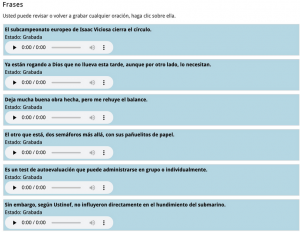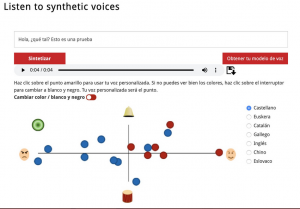Luis Medina is a 61-year-old journalist in Madrid. For 35 years he has reported on health issues, which means he has reported on diseases. Now one is making him lose his voice.
The Amyotrophic Lateral Sclerosis disease (more famous for its acronym, ALS) has paralyzed his body muscles. It started with weakness in his legs; he fell, which caused a brain hematoma. So he went to his doctor and got a diagnosis on May 8, 2019.
ALS has no cure so far. It is a rare, neurodegenerative illness with a very short life expectancy that progressively paralyzes the entire body.
Luis Medina’s throat muscles, vocal cords and pharynx are being affected. His voice is very weak. He can barely speak anymore.
When ALS patients lose their speech, a synthesized voice replaces theirs: a device converts texts into robotic sound words. Stephen Hawkins is a well-known example of how this works.
But now Luis Medina is able to use a voice with a more natural and human tone. His son, Alvaro Medina, the author of the eldiario.es story that reports on this, is donating his voice to him. This is made possible by a project of the Basque Country University, in the north of Spain, the Aholab Signal Processing Laboratory, and with the campaign #Donatuvoz.
It consists of a voice bank of donors who have recorded 100 sentences. In these sentences there are all the phonemes needed to create the voices, an average voice, writes Medina.
Sentences like: “They are already praying to God that it does not rain this afternoon, although on the other hand, they need it,” or “It leaves a lot of good work done, but it shuns the balance.”

The only devices required to donate is a computer and a simple microphone (the one in the headphones works.) The sentences are recorded on the platform –-the recording can be repeated several times if it goes wrong. The project’s specialists categorize by sex and age. The patient must contact Aholab, and its researchers select the voice that may be most suitable for the applicant.
If the patient has not yet lost their speech, they can also record their own, to be used when needed.

The voice doesn’t sound completely natural –this is still a synthesizer–but it does have a more familiar tone.
The project began 10 years ago. Álvaro Medina interviewed Inma Hernáez, founder of the laboratory, an expert teacher in speech synthesis. Hernáez first devised the Aholab with her sister in mind. She had cancer of the head and neck, so she was going to lose her voice. Since then, Hernáez told Medina, the project is intended for all people who have speech difficulties or have lost it, for whatever reason. It has continued with little funding.
While reporting on this story, Álvaro Medina talked about Aholab on Twitter last December. The avalanche of donations requests was such –3,000 in one day- that the website’s system couldn’t support them and is now under maintenance. “Given the number of comments and requests received on the development of the AhoMyTTS project, the system has had to stop. We hope to be operational in a short period of time. Thanks for your understanding.”
In the page cache one can read that the project is multilingual. It accepts donations in Spanish, Basque, Catalan, Galician, Slovak, Mandarin Chinese, Irish and English.
Luis Medina has already tested his new synthesizer with his son’s voice.
“Today is an important day. It is the first time that I use my son Alvaro’s voice, who has donated it to me so that I can leave that completely depersonalized and robotic voice common to all of us who use this type of technical aid,” he can be heard saying with Alvaro’s voice.
“It doesn’t improve the quality of life, but it does allow you a better emotional quality in communication, because you don’t feel like a stranger when you talk to another person. At least your voice is familiar,” he concludes.
